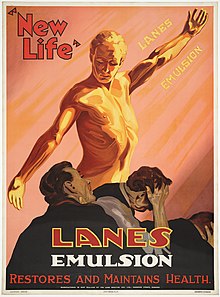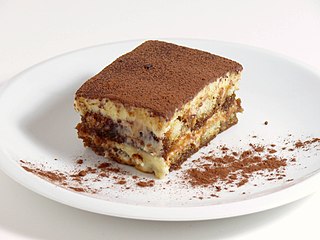
Tiramisu is a coffee-flavoured Italian dessert. It is made of ladyfingers (savoiardi) dipped in coffee, layered with a whipped mixture of eggs, sugar and mascarpone, flavoured with cocoa. The recipe has been adapted into many varieties of cakes and other desserts. Its origin is disputed between the Italian regions of Veneto and Friuli Venezia Giulia. The name comes from the Italian tirami su.
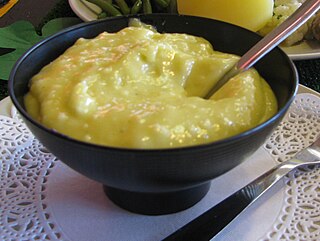
Aioli, allioli or aïoli is a cold sauce consisting of an emulsion of garlic and olive oil; it is found in the cuisines of the northwest Mediterranean.

Mayonnaise, colloquially referred to as "mayo", is a thick, cold, and creamy sauce commonly used on sandwiches, hamburgers, composed salads, and French fries. It also forms the base for various other sauces, such as tartar sauce, fry sauce, remoulade, salsa golf, ranch dressing, and rouille.

Pavlova is a meringue-based dessert. Originating in either Australia or New Zealand in the early 20th century, it was named after the Russian ballerina Anna Pavlova. Taking the form of a cake-like circular block of baked meringue, pavlova has a crisp crust and soft, light inside. The confection is usually topped with fruit and whipped cream. The name is commonly pronounced pav-LOH-və or pahv-LOH-və, and occasionally closer to the name of the dancer, as PAHV-lə-və.

Catalan cuisine is the cuisine from Catalonia. It may also refer to the shared cuisine of Northern Catalonia and Andorra, the second of which has a similar cuisine to that of the neighbouring Alt Urgell and Cerdanya comarques and which is often referred to as "Catalan mountain cuisine". It is considered a part of western Mediterranean cuisine.

Hollandaise sauce, meaning Dutch sauce in French, is a mixture of egg yolk, melted butter, and lemon juice. It is usually seasoned with salt, and either white pepper or cayenne pepper.

Eggnog, historically also known as a milk punch or an egg milk punch when alcoholic beverages are added, is a rich, chilled, sweetened, dairy-based beverage. It is traditionally made with milk, cream, sugar, egg yolks, and whipped egg whites. A distilled spirit such as brandy, rum, whisky or bourbon is often a key ingredient.

White pudding, oatmeal pudding or mealy pudding is a meat dish popular in Scotland, Ireland, Northern Ireland, England, Nova Scotia and Newfoundland.

Deviled eggs, also known as stuffed eggs, Russian eggs, curried eggs or dressed eggs, are hard-boiled eggs that have been peeled, cut in half, and filled with the yolk, mixed with other ingredients such as mayonnaise and mustard. They are generally served cold as a side dish, appetizer or a main course during gatherings or parties. The dish's origin can be seen in recipes for boiled, seasoned eggs as far back as ancient Rome, where they were traditionally served as a first course. The dish is popular in Europe, North America and Australia.
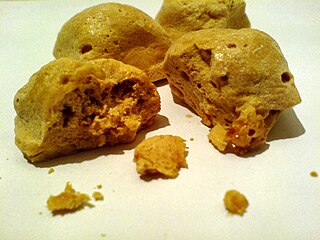
Honeycomb toffee, honeycomb candy, sponge toffee, cinder toffee, seafoam, or hokey pokey is a sugary toffee with a light, rigid, sponge-like texture. Its main ingredients are typically brown sugar and baking soda, sometimes with an acid such as vinegar. The baking soda and acid react to form carbon dioxide which is trapped in the highly viscous mixture. When acid is not used, thermal decomposition of the baking soda releases carbon dioxide. The sponge-like structure is formed while the sugar is liquid, then the toffee sets hard. The candy goes by a variety of names and regional variants.
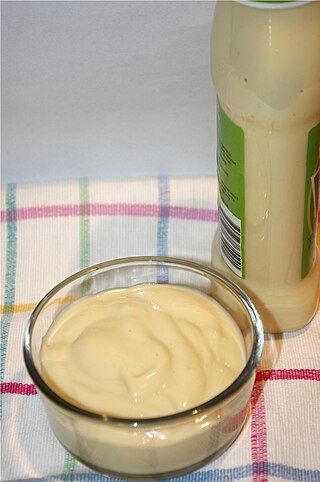
Salad cream is a creamy, pale yellow condiment based on an emulsion of about 25–50 percent oil in water, emulsified by egg yolk and acidulated by spirit vinegar. It is somewhat similar in composition to mayonnaise and may include other ingredients such as sugar, mustard, salt, thickener, spices, flavouring and colouring. The first ready-made commercial product was introduced in the United Kingdom in 1914, where it is used as a salad dressing and a sandwich spread.
Baconnaise is a bacon-flavored, mayonnaise-based food spread that is ovo vegetarian and kosher certified. It was created by Justin Esch and Dave Lefkow, founders of J&D's Foods, in November 2008, and sold 40,000 jars within six months. It was test-marketed in Grand Forks, North Dakota, to determine consumer interest. After being featured on both The Daily Show and The Oprah Winfrey Show, sales of Baconnaise increased significantly, with more than a million jars sold.

Edmund Giblett Allen (1844–1909) was a Liberal Party Member of Parliament in New Zealand.

Sponge cake is a light cake made with egg whites, flour and sugar, sometimes leavened with baking powder. Some sponge cakes do not contain egg yolks, like angel food cake, but most of them do. Sponge cakes, leavened with beaten eggs, originated during the Renaissance, possibly in Spain. The sponge cake is thought to be one of the first non-yeasted cakes, and the earliest attested sponge cake recipe in English is found in a book by the English poet Gervase Markham, The English Huswife, Containing the Inward and Outward Virtues Which Ought to Be in a Complete Woman (1615). Still, the cake was much more like a cracker: thin and crispy. Sponge cakes became the cake recognised today when bakers started using beaten eggs as a rising agent in the mid-18th century. The Victorian creation of baking powder by English food manufacturer Alfred Bird in 1843 allowed the addition of butter to the traditional sponge recipe, resulting in the creation of the Victoria sponge. Cakes are available in many flavours and have many recipes as well. Sponge cakes have become snack cakes via the Twinkie.

Robert Gillies was a 19th-century Member of Parliament in Otago, New Zealand. He was born in Rothesay on the Isle of Bute, Scotland.

Blair Athol (1861–1882) was a British Thoroughbred racehorse and sire. In a career that lasted little more than three months in the summer and autumn of 1864, he ran seven times and won five races including one walk-over. His wins included The Derby and the St Leger. Despite the brevity of his racing career, he was regarded by contemporary experts as one of the best British racehorses of his era and arguably the greatest horse ever trained in the North of England. He went on to become a highly successful stallion, siring the winners of many races.

Egg substitutes are food products which can be used to replace eggs in cooking and baking. Common reasons a cook may choose to use an egg substitute instead of egg(s) include having an egg allergy, adhering to a vegan diet or a vegetarian diet of a type that omits eggs, having concerns about the level of animal welfare or environmental burden associated with egg farming, or worries about potential Salmonella contamination when using raw eggs. There is a growing movement to address some of these concerns via third-party certifications, but because many labels in the industry remain confusing or intentionally misleading, some consumers distrust them and may use egg substitutes instead.

Cream of broccoli soup is a soup prepared with broccoli, stock, and milk or cream as primary ingredients. Ingredient variations exist, as do vegan versions. It is also a commercially, mass-produced soup, often sold in cans. Several recipes use canned cream of broccoli soup as an ingredient, such as its use with cooked chicken dishes and as a sauce.

A railway refreshment room is a catering facility attached to a railway station that was formerly common in Britain, Australia, New Zealand, and other countries that were formerly part of the British Empire. They were opened in the 19th century to serve passengers when trains did not convey catering facilities, and thus served passengers en route. Refreshment rooms were similar to tearooms, and generally served a variety of hot drinks, pastries, cakes, and light meals. With the introduction of buffet and restaurant cars, their importance began to decline.

Ashkenazi Jewish cuisine is an assortment of cooking traditions that was developed by the Ashkenazi Jews of Central, Eastern and Northern Europe, and their descendants, particularly in the United States and other Western countries.
10. Lane's emulsion -otherwise referred to as Lane's revulsion - was manufactured by PSM Holdings. The formula contained chloroform which was no longer permitted as an ingredient by the late 1980's. Reformulation attempts to replace the chloroform with alcohol and preservative were unsuccessful as the bacteria grew on the egg yolks and the final batch did not pass microbiology tests and was sold aa bird feed..
